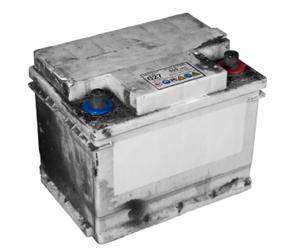| Complexity level: | 7 |
| Project cost ($): | 30 |
| Time required: | 1 hour to prepare, 1 hour for science fair project |
| Material availability: | Laboratory access and equipment required |
| Safety concerns: | Always handle chemicals with care. Safety gear (goggles, lab coats and gloves) should be worn when handling chemicals. |
Hypothesis
The combination of lead and copper in a Galvanic cell will produce the highest voltage.
Overview
Galvanic cells
A galvanic cell is actually an electrochemical device that uses a chemical reaction to produce electricity. This device is also called a voltaic cell. It was discovered by Luigi Galvani in 1780.
The Galvanic cell is made using 2 different types of metal. The metal electrode will be immersed in an electrolyte solution of the same metal base. The combination of metal electrodes in the solution is called a half cell. There will be 2 half cells separated by a porous cup or a salt bridge to form the Galvanic cell.

One of the half cells will release cations because of the metal oxidation that takes place. The 2nd half cell will be receive electrons which will combine with the cations to form the metal that will accumulate on the surface of the electrode. Once the electrodes are connected, the electrons will flow from the oxidizing half to the reducing half. The salt bridge or porous cup will help to keep the two different solutions apart while allowing the electrons to pass through so that the circuit is completed.
Scientific Terms
Materials
The materials required for the science fair project:
- 3 beakers
- 3 salt bridge
- 300ml zinc sulfide
- 300ml copper sulfide
- 300ml lead sulfide
- Zinc plate 25mm x 100mm
- Copper plate 25mm x 100mm
- Lead plate 25mm x 100mm
- 2 jumper wire with crocodile clip at both ends
- A digital voltmeter
- A marker pen
Procedure
1. For this science fair project, the independent variable is the type of metal electrodes and electrolyte solutions used. The dependent variable is the voltage produced by the Galvanic cell. This is measured using the digital voltmeter. The constants (control variables) are the amount of electrolyte solution, the size of the electrodes, the room temperature and the size of the salt bridge.
2. The zinc, copper and lead plates are first cleaned.
3. The 3 beakers are each filled with 300ml of zinc sulfide, copper sulfide and lead sulfide. The beakers are also labeled accordingly on the outside using the marker pen.
4. The metal electrodes are placed in the beakers according to the electrolyte solutions. For example the copper plate is placed in the beaker containing the copper sulfide.
5. The experiment is started using the beakers containing lead and copper. The two beakers are placed side by side and the salt bridge is placed in the beakers as shown in figure 1 above. The digital voltmeter is connected across the 2 electrodes and the voltage measurement is taken. The measured voltage is recorded in the table given below.
6. The procedure 5 is again repeated using the copper - zinc combination and zinc – lead combinations. The measured voltages are all recorded in the table given below.


Results
The results show that the lead and copper combination produced the highest voltage.
| Metals used in Galvanic cell | Lead - Copper | Copper - Zinc | Zinc - Lead |
| Measured voltage (V) | 0.473 | 0.097 | 0.049 |
Use the graph below to plot the results in the above table.

Conclusion
The hypothesis that the combination of lead and copper in a Galvanic cell will have the highest voltage is proven to be true.
Galvanic cells are used by us everyday in the form of batteries. The batteries are actually made of many such cells. Their applications include the simple batteries used in portable devices such as the torch light and also the batteries that are used in cars. Batteries are also used to store the electrical energy generated by solar panels and wind turbines. Similarly the electric car also depends on batteries to supply the energy required for them to operate.
Also consider
This science fair project can also be done using electrodes of different dimensions.
Try using different types of metal electrodes and solutions.
Try repeating the experiment at different room temperatures and compare the measured voltages.
References
Galvanic cell - http://en.wikipedia.org/wiki/Galvanic_cell
What is the galvanic cell? - http://www.wisegeek.com/what-is-the-galvanic-cell.htm

